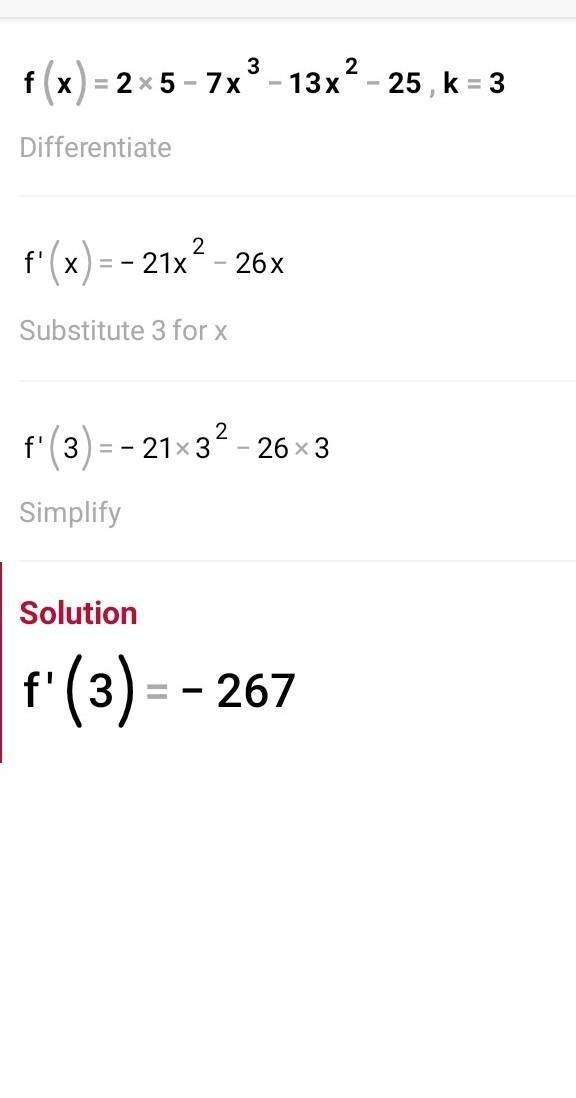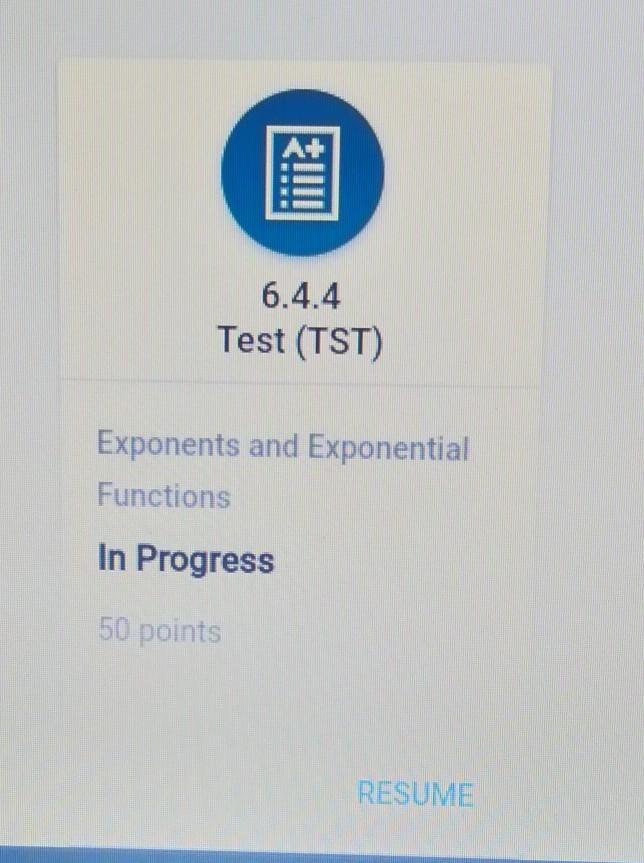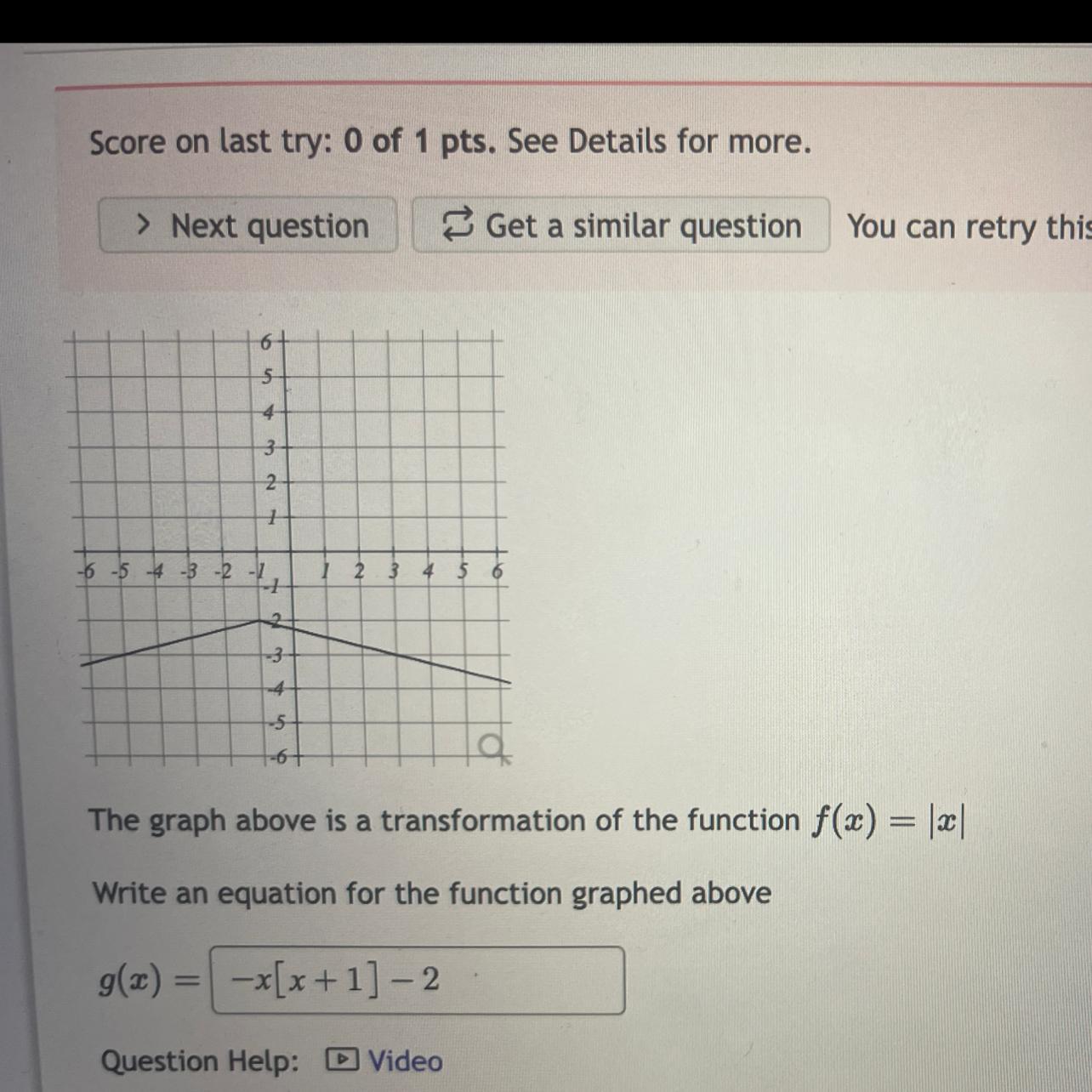Find the missing value.
K
N
75°
L
M
Answers
Answer:
N
Step-by-step explanation:
Yeah cos it's like n ya know ueuehd
Related Questions
Please HELP ASAP PLEASE?????!!!!

Answers
Answer:
-1
Step-by-step explanation:
Any number less than -2 (ex -3, -4, -5) are less than -2
Answer:
-1
Step-by-step explanation:
If you look at a number line, you will see that -1 comes before -2. Since -2 is a negative number, then the lower the number, the greater it is.
Picture included!
Find the unknowns in the graph below:

Answers
All the values of x, y and z are,
z = 12.99
y = 7.01
x = 28.3 degree
We have to given that;
In a triangle,
Two angles are, 61.7 degree and 90 degree
And, One side is, 14.76.
Now, We can formulate;
sin 61.7° = Perpendicular / Hypotenuse
sin 61.7° = z / 14.76
0.88 = z / 14.76
z = 0.88 x 14.76
z = 12.99
And, By Pythagoras theorem we get;
14.76² = z² + y²
14.76² = 12.99² + y²
217.85 = 168.74 + y²
y² = 217.85 - 168.74
y² = 49.1
y = 7.01
And, By sum of all the angles in triangle, we get;
x + 61.7 + 90 = 180
x + 151.7 = 180
x = 180 - 151.7
x = 28.3 degree
Learn more about the triangle visit;
brainly.com/question/1058720
#SPJ1
Last year there were 620 7th graders. This year the enrollment has increased by 105%. How many 7th graders are there this year?
Answers
Answer:
1,271
Step-by-step explanation:
620 + (105% × 620) =
620 + 105% × 620 =
(1 + 105%) × 620 =
(100% + 105%) × 620 =
205% × 620 =
205 ÷ 100 × 620 =
205 × 620 ÷ 100 =
127,100 ÷ 100 =
1,271
Choose the pair of numbers that is not a solution to the given equation. . (1, 2) (0, ) (4, 3)
Answers
The pairs of numbers given, (1, 2) is not a solution.
What is Equation?Equations are mathematical statements with two algebraic expressions flanking the equals (=) sign on either side.
It demonstrates the equality of the relationship between the expressions printed on the left and right sides. LHS = RHS is a common mathematical formula.
Coefficients, variables, operators, constants, terms, expressions, and the equal to sign are some of the components of an equation. The "=" sign and terms on both sides must always be present when writing an equation.
Given:
y= 2x+1 /3
Now, First value of x = 0
y= 2(0)+1 /3
y= 1/3
i.e., (0, 1/3)
and, Second value of x = 1
y= 2(1)+1 /3
y= 5/3
i.e., (1, 5/3)
and, Third value of x = 4
y= 2(4)+1 /3
y= 9/3
y=3
i.e., (4, 3)
Hence, from the pairs of numbers given, (1, 2) is not a solution.
Learn more about equation here:
https://brainly.com/question/10413253
#SPJ1
what is the domain and range?

Answers
Can anyone help me with this question please!???!??

Answers
Answer:
initial population : 89
after 9 years : 676
Step-by-step explanation:
no need for panic. this is just plain calculator mechanics. yes, we need to do some more complicated typing and use e, but it is still only typing.
the initial population is P(0). or t = 0.
simply when there were 0 years since the fish were added.
that is simple.
we get (as -0.42×0 = 0)
800 / (1 + 8e⁰) = 800 / (1+8×1) = 800 / 9 ≈ 89
now, after 9 years we have to calculate P(9). or t=9.
let's pre-calculate : -0.42×9 = -3.78
e to the power of -3.78 = 0.022822691...
8 times this is 0.182581531...
and plus 1 is 1.182581531...
800 / 1.182581531... = 676.486127 ≈ 676
Given tan A = − 12/35 and that angle A is in Quadrant IV, find the exact value of sinA in simplest radical form using a rational denominator.
Answers
Answer:
Sin A= − 12/37
Step-by-step explanation:
tan A = − 12/35
Reason for minus sign is because of it's in the fourth quadrant.
12 = opposite
35 = adjacent
? = Hypotenuse
12² + 35² = hypotenuse ²
1369 = hypotenuse ²
hypotenuse = √1369
hypotenuse= 37
Sin = -12/37
Reason for minus sign is because of it's in the fourth quadrant.
For the following polynomial function, use the remainder theorem to find f(k).
f(x)=2x5-7x³ - 13x² - 25; k= 3
Answers
Answer:
-267
Step-by-step explanation:
The answer is : f ' (3) = -267

can someone help me? I can't get rid of this test and it won't let me do it, I really don't know what to do and my grades will start to go down because I can't do it. (sorry if none of this makes sense)

Answers
Answer:
Step-by-step explanation:
There is no question to help with? Maybe ask your teacher or computer guy.
Use the distance formula to find the length of the segment C(2, 1) to
D(5,6). Round your answer to two decimal places.

Answers
Answer: 5.83
Step-by-step explanation:
\(\sqrt{(2-5)^2 + (1-6)^2}=\sqrt{34} \approx 5.83\)
a rectangular park has an area of 2/3 square mile. The length of the park is 2 2/3 the width of the park. What is the width of the park?
Answers
Answer: Area of the rectangular park = 2/3 square mile
Let us assume the width of the rectangular park = x
Then
The length of the rectangular park = 2 2/3 * x mile
= 8x/3 mile
Then
Area of the rectangular park = Length * Width
2/3 = (8x/3) * x
2/3 = 8x^2/3
(2 * 3)/3 = 8x^2
2 = 8x^2
x^2 = 2/8
x^2 = 1/4
x^2 = (1/2)^2
x = 1/2
So the width of the park is 1/2 feet.
hope this helps have a nice day❤️
Step-by-step explanation:
valuate the summation for the indicated value of the variable. 1(1!) + 2(2!) + 3(3!) + 4(4!) + m(m!); m = 3
Answers
The answer of the given question based on the expression is , the value of the summation when m = 3 is 137.
What is Expression?In mathematics, an expression is a combination of numbers, variables, and operators that represents a value or a set of values. It can be a simple combination of numbers and variables or a more complex combination involving mathematical operations like addition, subtraction, multiplication, division, exponents, and roots. Expressions can be used to represent a wide range of mathematical concepts, from simple arithmetic to complex functions and equations.
To evaluate the summation 1(1!) + 2(2!) + 3(3!) + 4(4!) + m(m!), where m = 3, we substitute m = 3 and simplify:
1(1!)+2(2!) +3(3!) +4(4!) +3(3!)
= 1(1) + 2(2) + 3(6) + 4(24) + 3(6) (since n! = n(n-1)! for all positive integers n)
= 1 + 4 + 18 + 96 + 18
= 137
Therefore, the value of the summation when m = 3 is 137.
To know more about Variables visit:
https://brainly.com/question/2466865
#SPJ1
Write an equation of a line in standard form, that is parallel to the line
4x - 2y = 8 that passes through the point (-2, 8).
Answers
Answer:
-2x+Y=12
Step-by-step explanation:
4x-2y=8
-4x -4x
-2y=-4x+8
-2 -2
Y= -4x/-2 + 8/-2
Y= 2x-4
M= 2
Y=mx+b
8=2 (-2) +b
8= -4+b
12=b
Y=2x+12
-2x -2x
-2x+Y=12
What is the slope of the line shown below?
(1,6) (-5,-7)
A. 13/6
B. -13/6
C. -6/13
D. 6/13
Answers
\((\stackrel{x_1}{1}~,~\stackrel{y_1}{6})\qquad (\stackrel{x_2}{-5}~,~\stackrel{y_2}{-7}) ~\hfill \stackrel{slope}{m}\implies \cfrac{\stackrel{\textit{\large rise}} {\stackrel{y_2}{-7}-\stackrel{y1}{6}}}{\underset{\textit{\large run}} {\underset{x_2}{-5}-\underset{x_1}{1}}} \implies \cfrac{ -13 }{ -6 } \implies \cfrac{13 }{ 6 }\)
Find the values of θ for which each equation is true.3. sin θ = 04, cos θ = 1
Answers
To find the values of θ
\(\theta\text{ = }\sin ^{-1}1\)\(\theta\text{ = }\frac{(4n+1)\pi}{2}\text{ for n }\in\text{ Z},\text{ that is, n is an integer}\)Let us pick some values of n, n = ..... -1, 0, 1.....
\(\begin{gathered} \theta=\ldots\ldots,\text{ }\frac{-3\pi}{2},\frac{\pi}{2},\frac{5\pi}{2},\ldots\ldots \\ \theta\text{ = }\ldots-270^0,90^0,\text{ 450}^0\ldots\ldots \end{gathered}\)4) Cos θ = 1\(\theta=\cos ^{-1}(1)\)\(\begin{gathered} \theta\text{ = 2n}\pi\text{ where n is an integer} \\ \text{For n = }\ldots.-1,\text{ 0, 1}\ldots.. \\ \theta\text{ = }\ldots\ldots.,\text{-2}\pi,\text{ 0, 2}\pi,\ldots\ldots \\ \theta\text{ = }\ldots.\text{-360}^0,\text{ 0, 36}0^0\ldots. \end{gathered}\)I am stuck please help with this graph.

Answers
An equation for the function graphed above include the following: g(x) = -1/4|x + 1| - 2.
How to interpret and determine the equation of g(x)?By critically observing the graph of this absolute value function, we can reasonably infer and logically deduce that the parent absolute value function f(x) = |x| was vertically compressed by a factor of 1/4, reflected over the x-axis, followed by a vertical translation 2 units down, and then a horizontal translation to the left by 1 unit, in order to produce the transformed absolute value function as follows;
f(x) = |x|
y = A|x + B| + C
g(x) = -1/4|x + 1| - 2
In conclusion, the value of the variables A, B, and C are -1/4, 1, and 2 respectively.
Read more on absolute value function here: brainly.com/question/28308900
#SPJ1
If you get it right I will give brainiest.

Answers
Find the inverse matrix or type
"none". (Use decimals)
[3 -1] [-5 3]
Answers
Answer:
I don't know if you mean [3,-1] & [-5,3] or \(\left[\begin{array}{ccc}3&-1\\-5&3\end{array}\right]\)
The inverse for first ones are "none" because they're not square matrices.
However the inverse for \(\left[\begin{array}{ccc}3&-1\\-5&3\end{array}\right]\) is \(\left[\begin{array}{ccc}0.75&0.25\\1.25&0.75\end{array}\right]\).
Hope this helps.
20 POINTS!! PLEASE HELP DUE NOWWW!
Gia started to solve the equation 3(x − 10) − 5x = 2x − 26 below. They want to move the variables to the left side of the equation for their next step.
Fill in Line 4 and give the property.
Line 1: 3(x − 10) − 5x = 2x − 26 Original Problem
Line 2: 3x − 30 − 5x = 2x − 26 Distributive Property
Line 3: -2x − 30 = 2x − 26 Collect Like Terms
Line 4: _______________ _______________
Answers
The value of x from the given equation is -1
Given the equation expressed as:
\(3(x - 10) - 5x = 2x - 26\)
Expand using the distributive law as shown:
3x - 3(10) - 5x = 2x - 26
3x - 30 - 5x = 2x - 26
Collect the like terms to have:
3x - 5x - 2x = -26 + 30
-2x - 2x = -26 + 30
Simplify the result by addition and subtraction:
-4x = 4
Divide both sides by -4 (Division property of equality)
-4x/-4 = 4/-4
x = -1
Hence the value of x from the given equation is -1
Learn more equations here: https://brainly.com/question/22688504
if a baseball team has lost 50 matches out of the 120 matches played in total find out their winning percentage
Answers
Answer:
58.3%
Step-by-step explanation:
120-50=70 (wins)
120 is 100% wins
70. ??
We multiply 70 by 100% then divide by 120.
The number of games won by the team can be calculated by subtracting the number of games lost from the total number of games played:
Number of games won = Total number of games played - Number of games lost
Number of games won = 120 - 50
Number of games won = 70
Now, we can calculate the winning percentage using the following formula:
Winning percentage = (Number of games won / Total number of games played) x 100%
Plugging in the numbers, we get:
Winning percentage = (70 / 120) x 100%
Winning percentage = 58.33%
Therefore, the winning percentage of the baseball team is 58.33%.
find ML
K 2x+5
M 5x-4
Answers
The figure labelled JKLM is a kite and the length ML is equal to 11.
What is a kiteA kite is a quadrilateral that have two pairs of equal length of sides and these sides are adjacent to each other. It can be viewed as a pair of congruent triangles with a common base.
The line JM bisects the kite into two congruent triangles, and thus;
the lengths ML and MK are equal.
ML = 5x - 4 and MK = 2x + 5 so;
5x - 4 = 2x + 5 {collect like terms}
5x - 2x = 5 + 4
3x = 9
x = 9/3 {divide through by 3}
x = 3
we substitute 3 for x;
ML = 5(3) - 4
ML = 15 - 4
ML = 11
Therefore, the value of length ML for the kite is equal to 11.
Know more about kite here:https://brainly.com/question/20597161
#SPJ1

help me please!!!!!!!!

Answers
Answer:
i don't understand sorry
Step-by-step explanation:
What is the measure of x?
61⁰ 90° 22° 29⁰
X + 7 3x - 5
Answers
What is an equation of the line that passes through the points (5,-8)
and (-5,4)? Put your answer in fully reduced form.
Answers
Answer:
y = \(-\frac{6}{5}\)x - 2
Step-by-step explanation:
Slope-Intercept Form: y = mx + b
Points: (5, -8), (-5, 4)
Slope: \(-\frac{6}{5}\)
y = \(-\frac{6}{5}\)x + b
-8 = \(-\frac{6}{5}\) ( 5 ) + b
b = -2
y = \(-\frac{6}{5}\)x - 2
#10 is this if y’all couldn’t see it

Answers
Answer:
Rectangle with l = 13 and h = 9
Step-by-step explanation:
To find the area of the rhombus, you multiply base and length.
The base here is 13 and the length is 9.
Multiplying 13 x 9 = 117.
The area of a square is side x side.
So, 11 x 11 = 121.
The area of the rectangle is length x base.
So 13 x 9 = 117.
We see the rhombus and rectangle have the same area.
Which statement correctly describes how to find an equivalent fraction for 60
Circle all the correct answers.
A Multiply 60 by a number and divide 100 by the same number
B
Add the same number to 60 and 100.
С
Subtract the same number from 60 and 100,
D Multiply 60 and 100 by the same number
E Divide 60 and 100 by the same number
A
B
C
D
E
Answers
Answer:
C and E
Step-by-step explanation:
Simplest form of 14/63
Answers
Answer:
2/9
Step-by-step explanation:
Answer:
2/9
Step-by-step explanation:
A parallelogram has sides measuring 10 and 18, and an angle measuring 100 degrees. What is its area?
Answers
Answer:
180
Step-by-step explanation:
The area of a parallelogram is given by the formula A = b × h, where b is the base and h is the height. In this case, the base is 10 and the height is 18. Therefore, the area is:
A=10×18
A=180
The area of the parallelogram is 180 square units
A bird can fly 5 miles in 15 minutes how many miles can it fly in 60 minutes?
Please show the process
Answers
The number of miles the bird can fly for 60 minutes is 20 miles.
How to find rate and distance?A bird can fly 5 miles in 15 minutes.
Let's find the rate before we can find the number of miles the bird can fly in 60 minutes.
Therefore,
rate = distance / time
rate = 5 / 15 = 1 / 3 miles per minutes
Therefore,
1 / 3 = d / 60
cross multiply
60 = 3d
d = 60 / 3
d = 20 miles
learn more rate here: https://brainly.com/question/12636854
#SPJ1
Find all points on the x-axis that are 16 units from the point (5,-8)
Answers
To find all points on the x-axis that are 16 units away from the point (5, -8), we can use the distance formula. The distance between two points (x₁, y₁) and (x₂, y₂) is given by the formula:
d = √((x₂ - x₁)² + (y₂ - y₁)²)
In this case, the y-coordinate of the point (5, -8) is -8, which lies on the x-axis. So, any point on the x-axis will have a y-coordinate of 0. Let's substitute the given values and solve for the x-coordinate.
d = √((x - 5)² + (0 - (-8))²)
Simplifying:
d = √((x - 5)² + 64)
Now, we want the distance d to be equal to 16 units. So, we set up the equation:
16 = √((x - 5)² + 64)
Squaring both sides of the equation to eliminate the square root:
16² = (x - 5)² + 64
256 = (x - 5)² + 64
Subtracting 64 from both sides:
192 = (x - 5)²
Taking the square root of both sides
√192 = x - 5
±√192 = x - 5
x = 5 ± √192
Therefore, the two points on the x-axis that are 16 units away from the point (5, -8) are:
Point 1: (5 + √192, 0)
Point 2: (5 - √192, 0)
In summary, the points on the x-axis that are 16 units away from the point (5, -8) are (5 + √192, 0) and (5 - √192, 0).
For more such questions on distance formula
https://brainly.com/question/28551043
#SPJ8